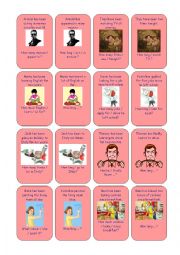
|
Go Fish: Present perfect continuous and simple 02
The whole set of cards was too big to fit in one post. This is the second sheet of three.
A card game based on the principle of “go fish” that practices the use of the present perfect continuous and present perfect simple tense. The set of cards consists of pairs. In each pair there is one card with a sentence in the present perfect continuous and one card with a sentence in the present perfect simple. Here is how it works:
1) The teacher deals 3 cards to each player. The player on the teacher´s left starts the game.
2) The player whose turn it is asks one other player for a card that would make a pair with one of her/his own cards. They can ask any player they want.
3) Asking is pursued as follows:
Let´s say that the player has a card with a sentence: “Tom has been reading for two hours.” Under the picture there are fragments of a question in the present perfect simple: How many pages / so far?” The card which makes a pair with this one has the answer to the question : “Tom has read 53 pages so far.” The player who is asking has to read the sentence written above the picture on their card: “Tom has been reading for two hours,” and make a question by which he/she asks for his opponents card: “How many pages has Tom read so far?”
4) If the player who has been asked has the card she/he is asked for, i.e. in our example “Tom has read 53 pages so far,” he/she replies by saying the answer and hands the card over to the player who asked for it. The player who has received the card puts down the pair and asks further for another card that would make a pair with a card she/he is holding. If they don´t have any cards left, they draw a card from the deck. Again, he/she can ask any player they want. If the player who has been asked doesn’t have the card she/he is asked for, they reply: “I don’t know. Go fish.”
5) The player who has asked for a card and hasn’t received it from her/his opponent draws a card from the deck and it is the turn of the player who has been asked. If the player who was asking draws the card they were asking for, they put down the pair and it is still their turn, i.e. they ask further. If he/she draws a card that makes a pair with another card in their hand, they have to wait until their next turn before they can put the pair down.
6) Let’s say that the player whose turn it is has a card with a sentence: “Tom has read 53 pages so far.” Under the picture there is the beginning of a question and a question mark “How long ... ?” In that case she/he asks: “How long has Tom been reading?”, and the player who has been asked replies either: “Tom has been reading for two hours,” or “I don’t know. Go fish.” The contrast between the tenses helps students realize the difference between their meaning.
7) The game proceeds until there are no cards left. The player with the most pairs wins.
Level:intermediate
Age: 14-17
Downloads:75 |
|
Copyright 28/1/2013 Tadeusz Szeryński
Publication or redistribution of any part of this
document is forbidden without authorization of the
copyright owner.
|


see more worksheets by [email protected]
|